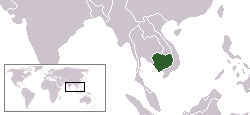United Nations Transitional Authority in Cambodia
| United Nations Transitional Authority in Cambodia | ||||||||||||
|
||||||||||||
| United Nations protectorate | ||||||||||||
|
||||||||||||
|
||||||||||||
|
Location of Cambodia in Southeast Asia.
|
||||||||||||
| Capital | Phnom Penh | |||||||||||
| Languages | Khmer | |||||||||||
| Political structure | United Nations protectorate | |||||||||||
| Special Representative of the Secretary-General |
Yasushi Akashi | |||||||||||
| History | ||||||||||||
| • | Paris Peace Accords | 23 October 1991 | ||||||||||
| • | UN Security Council Resolution 745 | 28 February 1992 | ||||||||||
| • | Cambodian general election | 23 May 1993 | ||||||||||
| • | Royal monarchy restored | 24 September 1993 | ||||||||||
| Area | 181,035 km² (69,898 sq mi) | |||||||||||
| Currency | Cambodian riel | |||||||||||
|
||||||||||||
| United Nations Transitional Authority in Cambodia | |
 |
|
| Abbreviation | UNTAC |
|---|---|
| Formation | 28 February 1992 |
| Type | Monitoring, peacekeeping |
| Legal status | Ended September 1993 |
|
Parent organization
|
United Nations Security Council |
| Website | UNTAC Website |
The United Nations Transitional Authority in Cambodia (UNTAC) (Khmer: អាជ្ញាធរអង្គការសហប្រជាជាតិ បណ្ដោះអាសន្ននៅកម្ពុជា) was a United Nations peacekeeping operation in Cambodia in 1992–93. It was also the first occasion on which the UN had taken over the administration of an independent state, organised and run an election (as opposed to monitoring or supervising), had its own radio station and jail, and been responsible for promoting and safeguarding human rights at the national level.
UNTAC was established in February 1992 under United Nations Security Council Resolution 745 in agreement with the State of Cambodia, the de facto government of the country at that time, to implement the Paris Peace Accords of October 1991. UNTAC was the product of intense diplomatic activity over many years.
Headed by Chief of Mission Yasushi Akashi (Japan), Force Commander Lieutenant-General John Sanderson (Australia), and Police Commissioner Brigadier-General Klaas Roos (Netherlands), UNTAC involved approximately 15,900 military, 3,400 civilian police, 2,000 civilians and 450 UN Volunteers, as well as locally recruited staff and interpreters. During the electoral period, more than 50,000 Cambodians served as electoral staff and some 900 international polling station officers were seconded from Governments. The whole operation cost over $1.6 billion, mostly in salaries for expatriates. The 45 participating countries providing military observers, police, or troops were:
UNTAC's aim was to restore peace and civil government in a country ruined by decades of civil war and Cold War machinations, to hold free and fair elections leading to a new constitution and to "kick-start" the rehabilitation of the country. It was to exercise 'supervision' or 'supervision or control' over all aspects of government, including foreign affairs, national defence, finance, public security and information, and to supervise, monitor and verify the withdrawal and non-return of foreign military forces; to canton, disarm and demobilise Cambodia's fighting factions, confiscate caches of weapons and military supplies, promote and protect human rights, oversee military security and maintain law and order, repatriate and resettle refugees and displaced persons, assist in mine clearance and the establishment of training programmes in mine clearance and mine awareness, rehabilitate essential infrastructure and assist in economic reconstruction and development.
...
Wikipedia



